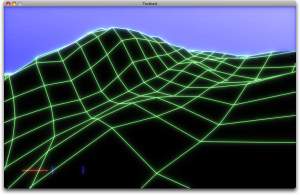 You can’t see the real new thing in this screenshot. The new thing is that I’ve added a whole bunch of new math to VectorStorm, and have a “fly camera” hooked up so you can actually fly the camera around freely and look at the world from any angle. Having a camera that you can fly around the world is a tremendously useful thing in any 3D game (in fact, virtually every 3D game out there has one of these during development, though they’re usually removed before shipping retail copies out to shops)
You can’t see the real new thing in this screenshot. The new thing is that I’ve added a whole bunch of new math to VectorStorm, and have a “fly camera” hooked up so you can actually fly the camera around freely and look at the world from any angle. Having a camera that you can fly around the world is a tremendously useful thing in any 3D game (in fact, virtually every 3D game out there has one of these during development, though they’re usually removed before shipping retail copies out to shops)
I also turned on backface culling, as overdraw and fill rate were starting to be an issue in the column-terrain rendering system I showed a screenshot of yesterday. Doesn’t make any difference at all in a simple scene like the one in today’s screenshot, though.
Incidentally, the terrain above (and from the last few days, for that matter) is randomly generated, and is different each time the testbed app runs. I’ve been making incremental improvements to it from day to day; I think today’s is beginning to look like mesh you might find in a real MMORPG setting (unlike the ones before, which were all either too bumpy or too flat). Right now it’s quite a small terrain, but there’s no reason why it couldn’t be much larger.
With all of that said, I’m not convinced that this type of heightmap approach is the best choice for use in the next generation of MMORPG Tycoon; I’m going to play around with a couple different options before really tying myself down to it. Whatever it ends up being, though, it needs to be easily editable by the simulated game designers, and the heightmap approach certainly does have that ability. I just worry that it’s a little bland visually, without generating a lot of textures and props to strew about on top of the terrain. And I’d really rather avoid doing that, if I can.


